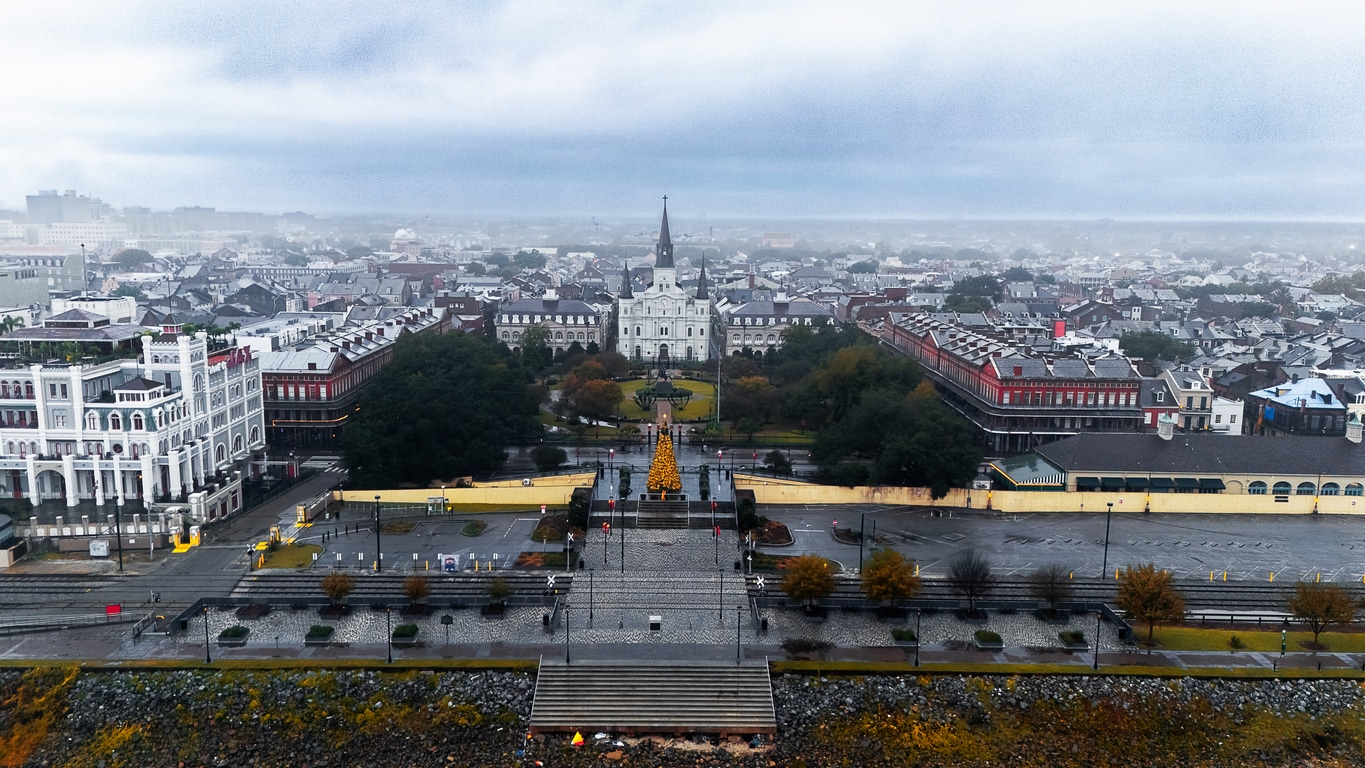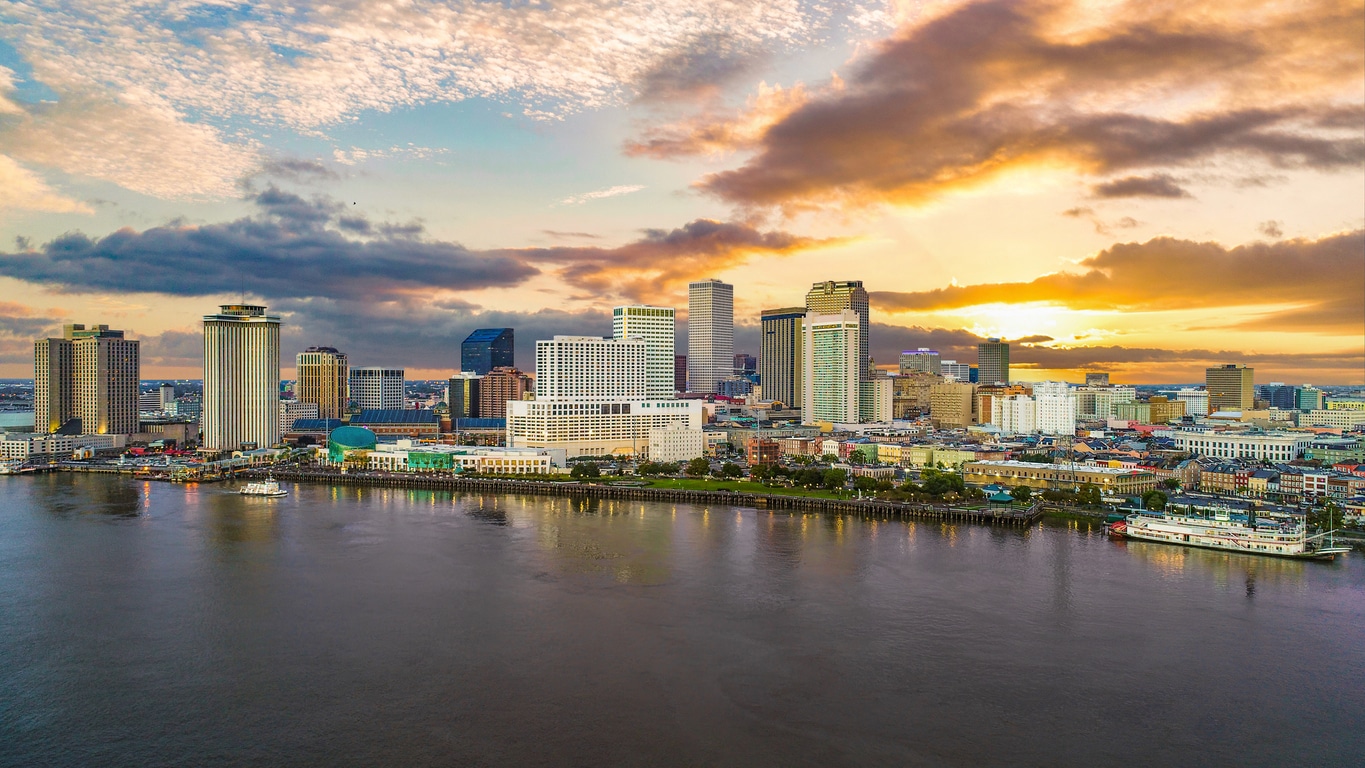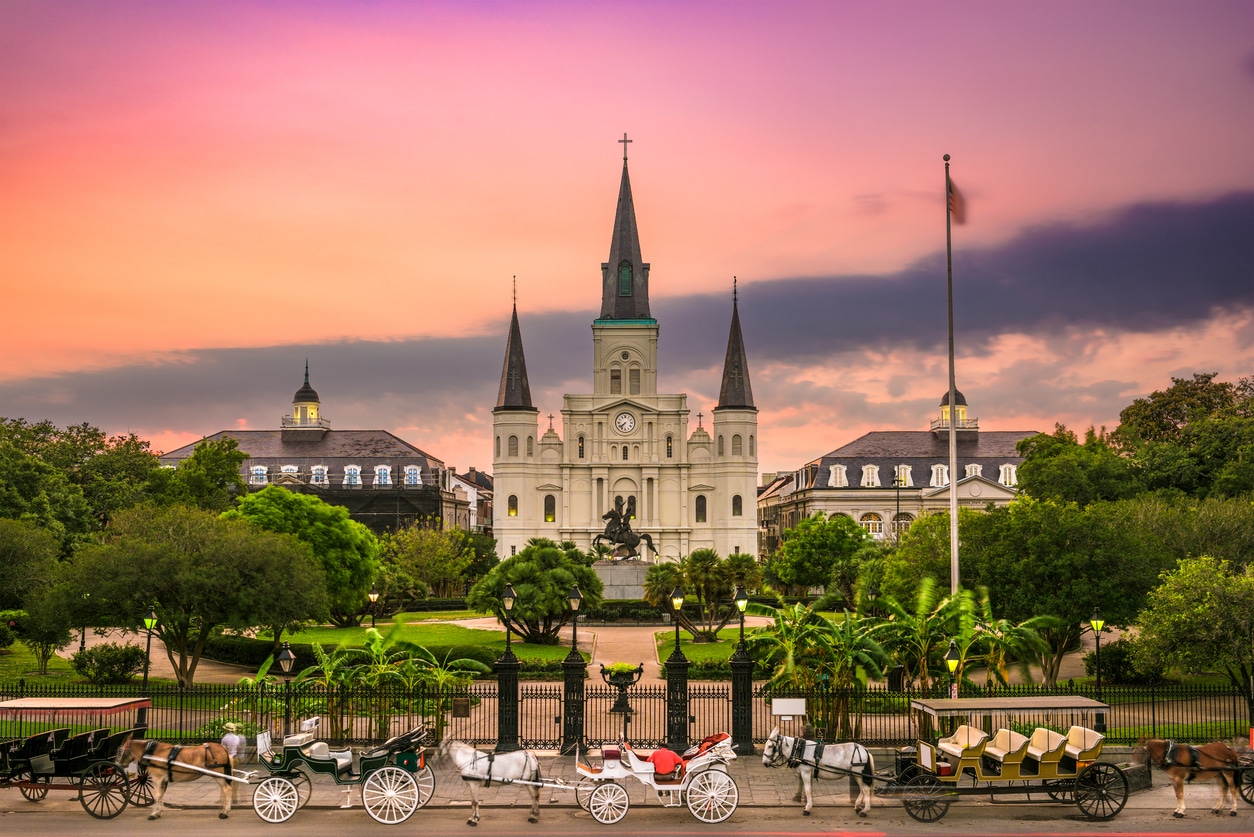As of 2025, 1,030,000 residents call NOLA home (a 0.9% increase from 2024)—and who can blame them? This jewel of the Louisiana bayou teems with culture, entertainment, cuisine, hospitality, and music on almost every corner.
Bourbon Street. Mardi Gras. Beignets at a French Quarter café. The robust flavors of a Cajun boil and the smooth resonance of a jazz club. These are just some of the dynamic attractions that make living in New Orleans such a desirable experience. But is moving to New Orleans the best choice for you?
To help answer this question, we’ve curated a list of things to know about living in New Orleans before you take the leap. Whether you’ll be moving to Louisiana from a couple states over or across the country, there’s a lot to consider when putting down roots in a new city, especially one as colorful and vibrant as The Big Easy.
So, let’s explore all you need to know—from the cost of living in New Orleans, to the job and housing markets, to the most unique activities to do in New Orleans, and so much more!
Planning a move to New Orleans? Get a fast, free quote today for your long-distance move. |

8 Things to Consider About Living in New Orleans (Before Moving to New Orleans)
Before you collect boxes or create a moving checklist, it’s a good idea to find out if NOLA makes sense for you to begin with. This historic Southern charmer has many diverse selling points to offer—but as with any long-distance relocation, moving to New Orleans is a major life decision. Does a new chapter here sound like your cup of tea (or bowl of gumbo)? Consider this your roadmap to all the ins and outs of living in New Orleans.
1) The cost of living in New Orleans is above the national average
Desirable cities often come with high prices—and The Big Easy is no exception. The cost of living in New Orleans currently sits at 12% above the national average and 17% above the Louisiana state average. But if you’re moving to New Orleans from another expensive urban area, you could be in luck. NOLA costs about 26% less than New York City, 22% less than San Francisco, 16% less than Seattle, 12% less than Washington D.C., and 10% less than Charleston.
Of course, you’ll need to account for taxes as well. Louisiana has the nation’s highest combined state and local sales tax rate of 9.56%, but it also ranks among the lowest in property and income tax rates—a noticeable savings if you’re used to 13% income taxes in a state like California.
What salary do you need to live comfortably in New Orleans? To afford all the basic expenses, along with money leftover for hobbies, entertainment, and any debts or financial investments, a single person will need to earn about $88,730 per year, while a family of four will need about $102,340. Sure, living in New Orleans can be hefty on the wallet, but keep in mind that you can maintain a comfortable quality of life here for around $6,700 per month versus at least $10,000 per month in a city like San Francisco.
2) Crime in New Orleans can be high—based on which area you’re in
Since it covers a large metro footprint with round-the-clock nightlife and millions of residents, the crime rate in NOLA is 183% above the national average. Folks have about a one in 72 chance of encountering a violent crime here and a one in 20 chance of encountering a property crime, versus the Louisiana state averages of one in 182 and one in 73.
But before those numbers deter you, it’s worth noting that violent crime has reached historic lows in 2025, declining by 20%. As with anywhere else, most crimes in New Orleans are concentrated in small pockets—here are the three safest neighborhoods in New Orleans and the neighborhoods where crimes are most likely to occur.
Safest neighborhoods in New Orleans
West End
Garden District
Lakeview
Highest crime neighborhoods in New Orleans
Tremé
Central City
Saint Roch

3) Living in New Orleans means balmy weather almost all year-round
New Orleans has a subtropical climate with about 216 days of sunshine and 64 inches of rainfall per year. The NOLA summers are humid with temperatures over 90 degrees, while the winters are mild with temperatures 45–60 degrees. Both the fall and spring months tend to be the most comfortable seasons, with temperatures hovering in the low 70s.
Due to its coastal location on the Mississippi River Delta near the Atlantic Ocean, hurricane and tropical storm activity can pose a serious threat in New Orleans. Each year, from June through November, hurricane preparations are an inevitable part of life here—in fact, some parts of the city are still recovering from the destruction of Hurricane Katrina in 2005. Before moving to New Orleans, you’ll want to factor in this extreme weather risk.
4) The New Orleans job market is currently somewhat of a mixed bag
Whether you’re relocating for a job in New Orleans or you want to explore the different career options once you arrive, keep in mind: NOLA has an unemployment rate of 5.7%—that’s considerably higher than the national average of 4.2%. Fortunately, job gains are on the rise across this metro area, with 478,000 positions created in 2025.
New Orleans is also home to a variety of exciting industries like tourism, digital media, biotech, hospitality, education, healthcare, aerospace, and international trade. In terms of annual salary, the median earner in New Orleans can expect to bring home about $65,570 per year ($32 per hour). This is more than you’ll earn in some other Southeast cities such as Tampa, Birmingham, and Charleston, but it’s slightly less than Nashville, Atlanta, and Raleigh.
5) New Orleans has surprisingly affordable housing
Despite a steep cost of living, the New Orleans housing market is actually quite reasonable. The average home costs around $244,690 (a 3.4% decrease from 2024), which is significantly cheaper than the national average of $368,580. Some of the best places to live in New Orleans are not only affordable, but full of cultural vibrancy and historic charm. Inflation is also declining across NOLA’s metro area, which makes this an excellent time to house hunt.
But if you’d prefer to hold off on buying a house, apartments in New Orleans are affordable, too. Rent for a one-bedroom apartment will cost you around $1,400 per month, compared to the national average of $1,754. Of course, this exact price can fluctuate based on where you live. For instance, an apartment in the French Quarter will set you back almost $2,600 per month, while apartments in Old Aurora only cost $1,063 per month.

6) The best places to live in New Orleans are brimming with character
New Orleans has 73 official neighborhoods. Does a waterfront enclave with outdoor recreation, family-oriented attractions, and a tranquil suburban feel sound like the perfect choice? Or how about a bustling urban core with accessible commuter options and a variety of entertainment all in walking distance? Whatever your preference, here are our picks for the three best places to live in New Orleans. For a full list, check out our guide to the best New Orleans neighborhoods.
Lakeview: Best for raising a family
About 15 minutes from downtown, Lakeview attracts families who want a suburban experience without sacrificing NOLA’s lively cultural heartbeat. Its top-notch schools, reliable safety ratings, abundant nature activities, and close-knit community make this neighborhood an excellent place to raise kids.
There’s also a variety of housing options, from quaint mid-century bungalows to spacious new construction. In terms of entertainment, plan an outing to the Carousel Gardens or Storyland Amusement Parks. Fish and bike along the shores of Lake Pontchartrain. Or treat yourself to ice cream cones at Creole Creamery on Harrison Avenue.
Central Business District: Best for young adults
Young adults flock to the Central Business District (CBD) for its prime downtown location. This diverse urban core speaks to creatives, professionals, or anyone else looking for both modern amenities and historic preservation.
As far as housing goes, you’lll find sleek high-rise apartments, converted townhomes, and cool industrial lofts. Plus, the 93 walk, 87 bike, and 81 transit scores deliver an effortless commute. Not only is CBD the main economic hub, it also pulses with buzzy entertainment. Attend a concert or live performance at the Saenger Theatre, peruse multimedia exhibits at the Contemporary Arts Center, root for the New Orleans Saints NFL team at Caesars Superdome, then enjoy cocktails and rooftop views on Fulton Street.
West End: Best for safety and affordability
Just a few miles north of downtown, West End strikes a convenient balance of safe, affordable living. This peaceful waterfront community on Lake Pontchartrain features numerous housing options to suit every income. Think: eclectic houseboats, cozy bungalows, modest single-family homes, vibrant Creole-style cottages, and walk-up condos or apartments.
West End is also one of the safer NOLA neighborhoods, known for a friendly atmosphere where the locals convene at lush parks and breezy marinas. No matter what you’re into, West End also offers easy access to entertainment for all budgets. Savor freshly caught seafood at The Blue Crab, meander through scenic West End Park, or explore the New Canal Lighthouse Museum.
Pro Tip: Save yourself time and keep your stuff safe by brushing up on how to pack for a move. |

7) Moving to New Orleans places fun activities right on your doorstep
Now that you have a clearer picture of where you’ll be living in New Orleans, let’s discuss what to put on the NOLA bucket list once you arrive. There’s no shortage of fun activities in The Big Easy — from cultural exhibitions to nature explorations and just about everything in between. Here’s a list of must-see New Orleans attractions to pique your interest.
Unique activities to do in New Orleans
Enjoy live performances and interactive sculpture gardens at Music Box Village.
Kayak through the pristine waters of Manchac Swamp and Bayou St. John.
Peruse the immersive gallery of local muralist Brandan “BMike” Odums at Studio BE.
Discover the French Quarter’s haunted past with a Ghost, Voodoo & Vampire Tour.
Free activities to do in New Orleans
Experience live music on Tuesday evenings outside the New Orleans Jazz Museum.
Stroll along the Mississippi River on paved scenic trails in Woldenberg Riverfront Park.
Watch the sidewalk artists, street performers, and tarot readers at Jackson Square.
Learn about NOLA’s history, from Civil Rights to Hurricane Katrina, at the Lower Ninth Ward Living Museum.
Activities to do in New Orleans with kids
Spend an afternoon at City Park’s Carousel Gardens and Storyland Amusement Parks.
Have an up-close encounter with marine and wildlife at the Audubon Zoo and Aquarium.
Cool off from the New Orleans humidity at the Ormond or West Bank Spray Parks.
Check out hands-on exhibits and sensory enrichment at Louisiana Children’s Museum.

8) New Orleans boasts an incomparable nightlife and festival scene
We can’t talk about living in New Orleans without mentioning the city’s iconic nightlife scene. From jazz clubs that have been around for almost a century, to annual Mardi Gras celebrations that spill onto the French Quarter streets — a spirited festival culture is woven into the fabric of NOLA’s identity.
The month-long Mardi Gras season alone draws in about one million locals and visitors alike. But this only begins to scratch the surface of all the community events that take place here year-round—here are some examples:
Now combine these seasonal festivals with a slew of historic jazz clubs, speakeasy lounges, irresistible restaurants, and eclectic performance venues, and it’s no wonder you get the boisterous, energetic atmosphere The Big Easy is famous for. However, as fun as a night out in NOLA can be, some parts of town get rowdier than others. Families might want to avoid Bourbon and Frenchman Streets where open containers are the norm, and the parties are wild. If you’re looking for a more relaxed (but no less enjoyable) vibe, check out Garden District and Uptown, which offer trendy breweries, elegant cocktail bars, and chic farm-to-table bistros.
Pros and Cons of Living in New Orleans
Is New Orleans a good place to live? As you can see, The Big Easy has so much to offer. Think: unique historic attractions, thrilling entertainment options, a cost-efficient housing market, and vibrant cultural traditions, just to name a few. These selling points make NOLA a desirable city to call home — but with all those benefits come potential drawbacks, too.
Here are the main pros and cons of living in New Orleans to help inform your decision.
Pros of living in New Orleans
Affordable housing market
Rich history and cultural diversity
Sunny, warm climate all year-round
Unrivaled entertainment and nightlife
Phenomenal music and cuisine
Numerous career opportunities
Many neighborhoods to choose from
Cons of living in New Orleans
Relatively steep cost of living
Elevated crime in certain areas
Seasonal risk of hurricanes
High unemployment rates
Atmosphere can be rowdy
Start Your New “Big Easy” Chapter with Colonial Van Lines
If you love the thought of dynamic culture, entertainment, heritage, and cuisine — and potentially high crime rates and cost of living aren’t deal breakers for you — then moving to New Orleans should be right at the top of your to-do list.
When it’s time to embark on this new adventure, let Colonial Van Lines handle all the logistics of your relocation. With over 50 years of long-distance moving experience, our highly trained team will ensure a smooth-as-jazz transition to The Big Easy. Contact us for a free moving quote today.

